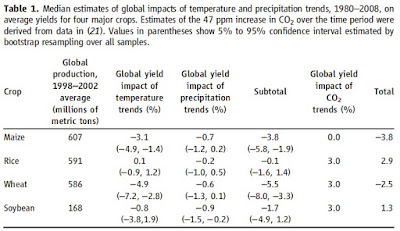A recent post discussed the effect of climate change on the food supply. I now
have a little more information.
I start with the table from Lobell et. al. 2011 which I showed in my previous post:

The issue was the effect on food supply, so it matters how much of each crop is used for food.
Of the 440 million metric tons (MMT) of polished rice produced in the world in 2010 ( Table 1), 85% went into direct human food supply ( 5 ) . By contrast, 70% of wheat and only 15% of maize production was directly consumed by humans. (Major Cereal Grains Production and Use Around the World)
Googling around, it looks as though about 6% of soybean production is used directly as human food, 75% as animal feed, some of the rest as soy oil consumed by humans. I can't find a figure for the total fraction used to feed humans, so am guessing 10%. We then have:
Production and yield are from Table 1 above. The bottom right cell shows a net increase in the amount of the four crops used as human food of about a million metric tons. For a more precise calculation I should have converted tons of each crop into calories. I am assuming that the ratio is not very different for the different crops, but readers are welcome to check that.
In the course of the same conversation, one of the participants insisted that all studies of the future effect of climate change on the food supply showed it to be negative. I don't generally like getting into the game of dueling citations, for reasons I will probably discuss in another post. But I was referred to the latest IPCC report so looked at it, and found a table, Figure 7.5 in Chapter 7, that showed the distribution of predictions of the effect of climate change on mean crop yield over the 21st century. For both temperate and tropical regions, the median prediction was for a negative effect but more than 25% of the studies predicted a positive effect. Looking at the estimates that included the effect of adaptation, farmers changing what they did in response to changing circumstances, the median prediction was for a reduction in yield of less than half a percent per decade.
I think that supports my view of the effect of climate change both on the food supply and more generally–that there are both positive and negative effects, both are quite uncertain, and the sum might turn out to be negative or positive, might make us worse off or better off.


8 comments:
I'm not sure why you exclude "used as animal feed". Some of that is probably pet food, but I would guess the lion's share of it is fed to agricultural animals which are then milked and/or slaughtered to feed humans, so that's still part of the human food supply.
The other non-food use is biofuel, which I think is significant only for maize and soy.
The largest change for the four crops is -3.8 percent. Does anyone really think that will be anything but a matter of academic debate (i.e., whether it is actually occurring)?
Before mid-century, cultured meat will probably largely replace animal meat. A quick Google check appears to indicate that 5 times as much grain in the U.S. goes to feeding animals as goes to feeding humans. So converting even a small fraction of meat consumption to cultured meat would dwarf any negative effects of climate change.
In the last sentence of the 2nd last paragraph, you've typoed "median prediction" as "media prediction". That actually had me confused for a brief moment. :) Good post, cheers.
The c4 rice project succeeds it will be a moot point. We may be at Peak Farmland
and Potatoes.
Sorry it should have said The c4 rice project succeeds it will be a moot point. We may be at Peak Farmland.
An interesting though occured to me while browsing the AR5 reports.
One way the AR5 reasons about food security is by looking at the effect of climate change on food prices. So they spend a lot of pages on discussing whether, and how, climate change will increas the price of food.
In increase in food prices however could mean a income/wealth transfer to the food producers, from the non food producers. And isn't that something that Liberals are in favor of?
Someone on Greg Cochran's site said the weather changes in climate change are probably overrated, and the changes in what diseases flourish where are probably underrated.
Well, for climate change in general I agree enough with the "increasing tail-risk" and creating unknowns in a system that has been stable for a few hundred million years.
While it appears that a greater CO2 helps crop and plant growth,there is the worry of mankind continuing to populate, expand, and continue to reduce total forestry growth areas of the world. So, while CO2 levels increase, the total global land to compensate with carbon-filled trees decrease.
Food for thought article though. Freeman Dyson and his idea for climate change carbon control.
http://e360.yale.edu/content/feature.msp?id=2151
Post a Comment